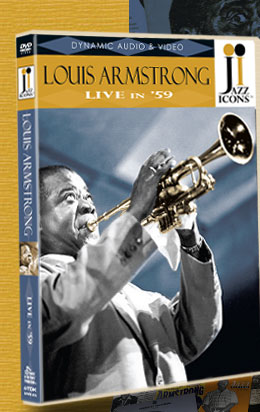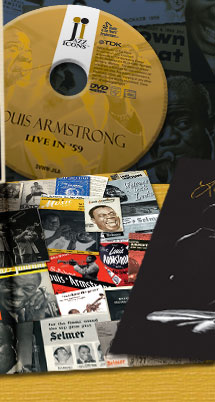




 |
 |
|
|||
|
|
|
||||
|
|
|
||||
|
|
|
||||
|
|
|
||||
 |
|
||||
 |
|
||||
 |
|
||||
|
|
|
|
|
|
|
 |
 |
 |
 |
Jazz Icons: Louis Armstrong is one of the only known complete Armstrong concerts from the 1950s to be captured on film. This 55-minute set, filmed in Belgium in 1959, features many of Satchmo’s greatest songs including “Mack The Knife”, “When It’s Sleepy Time Down South” and “Stompin’ At The Savoy,” backed by his stellar band the All-Stars, featuring Trummy Young, Peanuts Hucko, Billy Kyle, Danny Barcelona and Mort Herbert. |
|
 |
|
Trumpet, Vocal : Louis Armstrong Clarinet: Peanuts Hucko Trombone: Trummy Young Piano: Billy Kyle Bass: Mort Herbert Drums: Danny Barcelona Vocal: Velma Middleton |
When It’s Sleepy Time Down South (Back Home Again In) Indiana Basin Street Blues Tiger Rag Now You Has Jazz Love Is Just Around The Corner C’Est Si Bon Mack The Knife Stompin’ At The Savoy St. Louis Blues Ko-Ko-Mo (I Love You So) When The Saints Go Marching In La Vie En Rose |
16-page booklet Foreword by Wynton Marsalis Liner notes by Rob Bowman Cover photo by Herman Leonard Booklet photos by Paul Hoeffler, Bob Willoughby, Susanne Schapowalow, Jamie Hodgson Memorabilia collage Total time: 55 minutes |
|
|
Foreword: Louis Armstrong’s sound transcends time and style. He’s the most modern trumpet player we’ve ever heard and the most ancient…at the same time. He has light in his sound. It’s big and open with a deep spiritual essence—a sound closest to the Angel Gabriel. You can’t practice to get Louis Armstrong’s sound. It’s something within him that just came out. Rhythmically, he’s the most sophisticated player we’ve ever produced. He places notes unpredictably with such great timing—always swinging, always coordinated—with overwhelming, transcendent power. This DVD captures that intangible power and allows us to gaze upon it in wonder. —Wynton Marsalis
Sample Liner Notes by Rob Bowman: In the spring of 1959, when Louis Armstrong took the stage in Belgium to play the concert captured on this DVD, he had much to smile about. The irrepressible trumpeter and singer had cut his first records with King Oliver’s Creole Jazz Band some thirty-six years earlier. In the interim, he had completely redefined the possibilities of both instrumental jazz and popular singing. His concept of what it meant to swing had become the very essence of jazz rhythm, and his ceaseless ability to create coherent melodic improvisations over a given set of chord changes had reconstructed the very nature of the jazz ensemble. Along the way, he significantly raised the bar with regard to instrumental virtuosity. As a vocalist, Armstrong was equally accomplished. His penchant for phrasing just behind the beat influenced countless other singers including Bing Crosby. Finally, for all intents and purposes, he popularized scat singing, as early as the 1926 recording of “Heebie Jeebies” when he improvised vocal lines using nonsense syllables in place of English words. As the esteemed jazz critic Leonard Feather put it in the New York Times, “Armstrong’s career set the pattern for the development of American jazz.”
The version of the All-Stars featured on this DVD included trombonist Trummy Young, clarinetist Peanuts Hucko, pianist Billy Kyle, bassist Mort Herbert and drummer Danny Barcelona. James “Trummy” Young was the longest-serving member of the band at the time, having replaced Jack Teagarden in 1952. Born in Savannah, Georgia, in 1912, Young started out playing trumpet and had grown up idolizing Armstrong. As a trombonist, he originally came to prominence playing with Earl Hines from 1933 to 1937. Young spent the next six years with the dynamic Jimmie Lunceford Orchestra, afterwards serving shorter stints with Charlie Barnet, Benny Goodman and Billy Eckstine. From 1947 to 1952 he lead his own band in Hawaii, at which point he joined forces with Armstrong. In addition to his superb trombone playing, Young was a gifted vocalist. One of the highlights of this DVD is his vocal duet with Armstrong on the All-Stars’ 1956 hit “Now You Has Jazz.” Also dig the background riffs on this tune, reminiscent of the sort of background strutting one would hear with Louis Jordan’s Tympani 5. Young left Armstrong in 1964, settling back in Hawaii until his death twenty years later.
This may be the only complete performance by Louis Armstrong that exists on film. This rare treasure represents an important document of one of the most important jazz musicians ever. Sing it, or should I say swing it, Pops. All words and artwork on this page ©Reelin' In The Years Productions. Unauthorized use is prohibited. |
|
Site contents ©Copyright 2006 Reelin' In The Years Productions
Site designed by Tom Gulotta